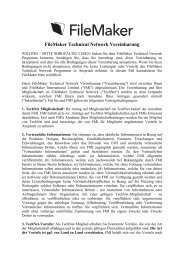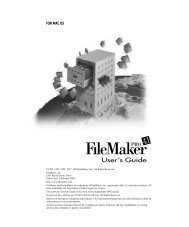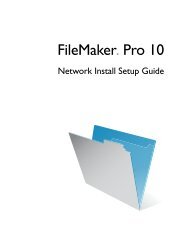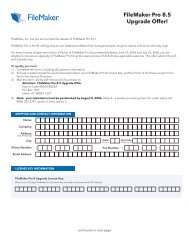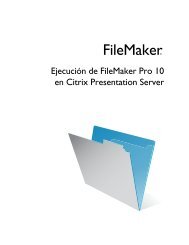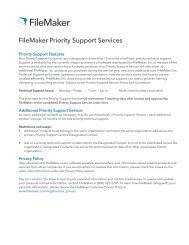Guida di FileMaker Server 12
Guida di FileMaker Server 12
Guida di FileMaker Server 12
You also want an ePaper? Increase the reach of your titles
YUMPU automatically turns print PDFs into web optimized ePapers that Google loves.
Risoluzione dei problemi Miglioramento delle prestazioni<br />
Miglioramento delle prestazioni<br />
Nota Le seguenti informazioni sono destinate ad amministratori server.<br />
Per garantire prestazioni migliori, <strong>FileMaker</strong> <strong>Server</strong> deve essere utilizzato su una macchina<br />
de<strong>di</strong>cata, riservata all’utilizzo come server <strong>di</strong> database. Se <strong>FileMaker</strong> <strong>Server</strong> ospita <strong>di</strong>versi client o<br />
un elevato numero <strong>di</strong> file <strong>di</strong> database, utilizza una grande quantità della potenza del processore,<br />
dello spazio del <strong>di</strong>sco rigido e della capacità <strong>di</strong> rete. I software che richiedono un uso intensivo del<br />
processore o un elevato traffico <strong>di</strong> rete sulla stessa macchina rallentano l’esecuzione <strong>di</strong><br />
<strong>FileMaker</strong> <strong>Server</strong> e riducono le prestazioni <strong>di</strong> <strong>FileMaker</strong> Pro sulle macchine client.<br />
• <strong>FileMaker</strong> <strong>Server</strong> non deve essere installato su una macchina che opera come stazione <strong>di</strong><br />
lavoro primaria o come server <strong>di</strong> file in rete.<br />
• Non è possibile eseguire due <strong>di</strong>verse versioni <strong>di</strong> <strong>FileMaker</strong> <strong>Server</strong> contemporaneamente<br />
sulla stessa macchina.<br />
• Non utilizzare la macchina su cui viene eseguito <strong>FileMaker</strong> <strong>Server</strong> come server <strong>di</strong> posta<br />
elettronica, <strong>di</strong> stampa o <strong>di</strong> file.<br />
• Non utilizzare il software <strong>di</strong> backup del sistema per eseguire il backup dei database ospitati<br />
da <strong>FileMaker</strong> <strong>Server</strong>. Utilizzare invece l’Admin Console <strong>di</strong> <strong>FileMaker</strong> <strong>Server</strong> per<br />
programmare il backup dei database.<br />
• <strong>FileMaker</strong> consiglia <strong>di</strong> specificare una cartella <strong>di</strong> backup progressivo su un hard <strong>di</strong>sk <strong>di</strong>verso<br />
rispetto a quello in cui sono contenuti i database ospitati. Poiché le mo<strong>di</strong>fiche progressive<br />
possono essere riportate nella cartella <strong>di</strong> backup progressivo quasi contemporaneamente<br />
alle mo<strong>di</strong>fiche nei database ospitati, l’utilizzo <strong>di</strong> due hard <strong>di</strong>sk <strong>di</strong>versi può migliorare le<br />
prestazioni del server.<br />
• Non utilizzare software antivirus per eseguire la scansione delle cartelle che contengono i<br />
file <strong>di</strong> database ospitati.<br />
• Disattivare gli screen saver e la modalità sleep (o ibernazione e standby) sul server. Queste<br />
funzioni del sistema operativo riducono le prestazioni o impe<strong>di</strong>scono <strong>di</strong> accedere ai<br />
database ospitati.<br />
• Utilizzare un hard <strong>di</strong>sk veloce, un sistema RAID a più <strong>di</strong>schi o una rete <strong>di</strong> stoccaggio (SAN)<br />
per i database ospitati.<br />
• Se si utilizza la versione a 64-bit <strong>di</strong> <strong>FileMaker</strong> <strong>Server</strong> su un sistema a 64 bit, è possibile<br />
aumentare l’impostazione RAM riservata alla cache dei database. La cache della RAM<br />
massima per i sistemi a 32 bit è 800 MB. La cache della RAM massima per i sistemi a 64 bit<br />
è 1 TB.<br />
• Il server database crea i file temporanei in una <strong>di</strong>rectory temporanea sul computer master<br />
per memorizzare nella cache i dati per i file ospitati. Il server database crea un file<br />
temporaneo per ogni file ospitato aperto e chiude ed elimina automaticamente il file<br />
temporaneo quando il file ospitato associato viene chiuso. Assicurarsi che vi sia spazio<br />
libero su <strong>di</strong>sco sufficiente sul computer principale per memorizzare i file temporanei. Nella<br />
maggior parte dei casi, la <strong>di</strong>mensione del file temporaneo corrisponde al 10-20 % delle<br />
<strong>di</strong>mensioni del file ospitato associato, ma la percentuale reale <strong>di</strong>pende dal numero <strong>di</strong> client<br />
e <strong>di</strong> script lato server e dal loro livello <strong>di</strong> attività. Il server database controlla perio<strong>di</strong>camente<br />
le <strong>di</strong>mensioni dei file temporanei e riduce le <strong>di</strong>mensioni <strong>di</strong> un file temporaneo se <strong>di</strong>venta<br />
troppo grande rispetto alla quantità <strong>di</strong> spazio libero su <strong>di</strong>sco.<br />
• Disattivare l’in<strong>di</strong>cizzazione dei file (su Windows, Servizio <strong>di</strong> in<strong>di</strong>cizzazione; su Mac OS,<br />
Spotlight; o qualunque altro software <strong>di</strong> in<strong>di</strong>cizzazione dei file <strong>di</strong> terze parti). Questa<br />
funzione riduce le prestazioni.<br />
GUIDA DI FILEMAKER SERVER <strong>12</strong> 167



